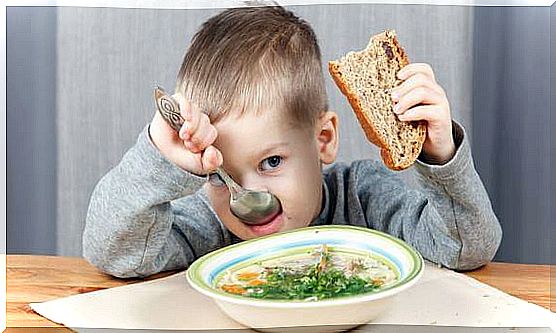3 Reasons Why A Child Should Not Be Forced To Eat

According to expert recommendations, it is a good idea for a child to start training to eat solid food at about 6 months of age. Getting to know new foods is called expanding your diet.
Getting your baby used to new foods requires patience from parents. Parents see it as a duty to expand a child’s diet, and many of us have a firm belief that children are forced to start eating solid foods at a certain age. At its worst, this kind of attitude leads to the parents forcing the child to eat.
The topic is of interest to many mothers also because they want to stop breastfeeding as early as possible. The problem is that babies are usually in no hurry to start eating new foods and giving up breast milk. Every parent knows how difficult it can be to get a child to eat, and meal time is the most challenging moment of the day in many families.
Why should a child not be forced to eat?
All those little “planes” and “trains” we have to clean off the floor are an indication of how hard it is for a child to get used to new foods. It is true that at a certain stage of growth, a baby needs more nutrients in his diet, but even so, forcing a child to eat is not a good way.
The fact that a clinic nurse or doctor tells you to add grains and vegetables, for example, to a child’s diet does not mean that the child will learn to eat these foods overnight. It’s important to let the child eat in their own way and at their own pace – everything else is unnecessary coercion.

Expanding the diet does not mean that the child’s entire diet is put on a new one at a time. It is a good idea to add foods to your child’s diet little by little one at a time. One common mistake parents make is that they start offering children the same foods they eat. It is often thought that if a child is not provided with adult food, this will not get the necessary nutrients. However, this is not the case.
1. Daily nutritional needs according to age
Experts have made general recommendations for the daily amount of food for babies. However, measuring the amount of food can fail for many reasons. One reason is the variation in food concentration; for example, home-made porridge can be very frothy or thicker.
If a child does not complete a dose, it is difficult to estimate how much food he or she still needs. In addition, the amount of breast milk fed to the baby should be taken into account in the calculations so that the baby does not eat too much. It is important to remember that all children are different and have different nutritional needs.
The average daily dietary requirements of children are described below:
- 6 months: Girls about 819 kcal, boys up to 779 kcal
- 9 months: Girls up to 859 kcal, boys up to 924 kcal
- 12 months: Girls about 500-1000 kcal, boys 479-1169 kcal
- 18 months: Girls and boys about 1200 kcal
- 24 months: Girls up to 1273 kcal, boys up to 1300 kcal
2. A complementary diet is complementary
If a child is forced to eat supplementary foods as his or her primary diet, he or she may get too much or too little of the nutrients he or she needs, which can be detrimental to health. The baby’s need for nutrients is gradually increasing. The gender of the child also matters in the amount of calories needed daily. Sometimes parents force a child to eat more than is necessary. For example, two children of the same age may not have to eat the same amount. Also, a child should not be compared to, for example, a sibling or a friend who eats more.
As a child’s diet begins to expand, breast milk should continue to be the child’s main source of nutrition. Purees, porridge and other foods are a complementary food. It doesn’t matter if the child wants to eat or not. The child knows very well himself how much he needs to eat and should not be forced to eat.

3. If solid food does not taste
No matter how tempting the recipe may be, a child who has eaten breast milk all his life is not used to solid food. Not only does the baby not understand anything about spoons and plates, he also doesn’t know how to move solid food in his mouth yet. The habituation process is slow and the child should not be rushed.
It is advisable to let the child get used to the new foods in their own way. Before a child decides to eat food on a plate, it must feel comfortable and safe for him or her. The child should be allowed to feel the food with their hands and should have time to get used to the new scents.
The child may be offered solid food in chunks instead of pureed or mashed food. For example, he can be given fruit cut into small sticks or pieces or a whole vegetable. The most important thing is that the child is not pressured about food. If a child doesn’t want to eat at a certain point in time, that’s not a problem.
Serving unfamiliar foods can also be a great way to encourage a child to try new things. Ask the child if he wants to take a piece of fruit in his hand and maybe taste it. A child’s taste develops over time, not in one day. There is always some food that a child does not like and no one should be forced to eat such food. Always try to put yourself in the position of a child.









